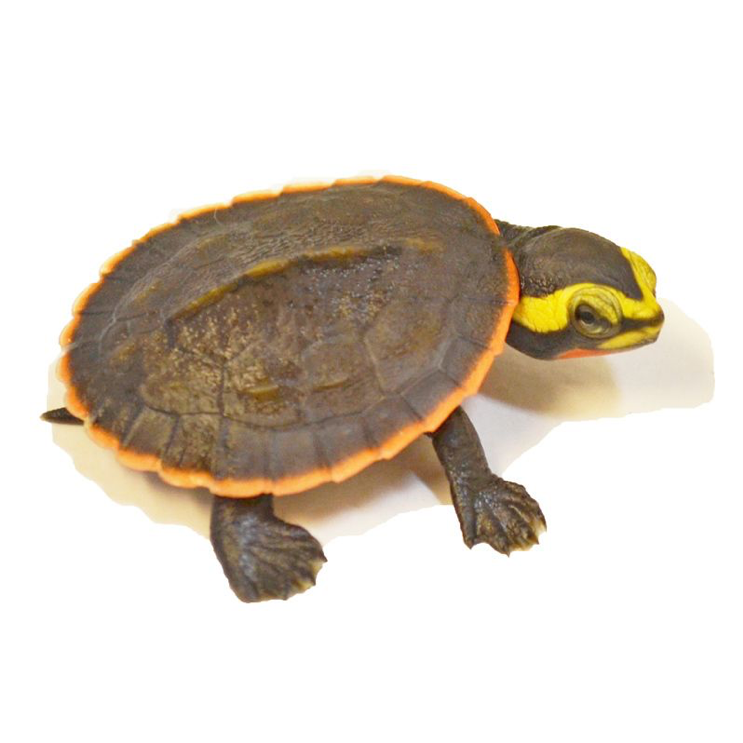
Pink Bellied Side-necked Turtle Caresheet
Introduction
There are a number of different species of Side-necked turtles, but they all live in the southern hemisphere in countries such as Australia and Argentina. One species of Side-necked turtle which we supply here at Turtle Creek is the Pink-Bellied Side-necked Turtle (Emydura subglobosa) , which comes from Australia and Papua New Guinea. This species of turtle can grow to around 10 inches in length. Although there are a number of different species of Side-necked turtles, the habitats in which they live, and their housing requirements are similar for the most part.
Pink-Bellied Side-necked turtles are often found in creeks, lakes and slow-moving rivers. They are not avid baskers and spend nearly all their time in the water. They are obviously quite a strange looking turtle as they have such a long and snake like neck. Pink-bellied side neck-turtles can live over 30 years old.

Pink-Bellied Side-necked Turtle Photo
Habitat and Housing
Hatchling Pink-Bellied Side-necked turtles can be kept in a 2 to 3 foot long aquarium. Adults however will require a much larger aquarium or ideally a pond as some Pink-Bellied Side-necked turtles can exceed 14 inches in length. The water depth should be at least twice the width of the turtle’s shell. The water temperature should range between 21-26 degrees Celsius. This can be achieved using an aquarium heater. An underwater hiding place should be provided where the turtle can hide but cannot become trapped and drown.
Although some Pink-Bellied Side-necked turtles are not avid baskers, a basking area is still crucial, where the turtle can leave the water completely and fully dry off. The basking area’s temperature should be between 30-35 degrees Celsius. This can be provided by fitting a heat lamp to your aquarium. Pink-Bellied Side-necked turtles require UVB lighting to survive. UVB provides the turtle with vitamin D3 which then enables the turtle to absorb Calcium from its food. Without Vitamin D3 the turtle will develop metabolic bone disease (MBD) and eventually die. This can be provided by using bulbs which emit UVB which are readily available from any pet shop.
Water quality is very important as the turtles can develop health issues due to inadequate water quality. One way to help ensure good water quality is by using an aquarium or pond filter. External filters are generally more suitable than internal filters as they are larger, and the turtle cannot dislodge the filter causing it to malfunction. Frequent water changes are also necessary to ensure good water quality. Artificial plants, stones and logs should be added to the enclosure to create a more natural look and feel.
Feeding and Diet
Pink-Bellied Side-necked Turtles are predominately carnivorous, so they will require foods that are high in protein and calcium. Good foods include; fish, worms, insects, frogs and snails. However, they will also consume plant matter such as aquatic plants. Furthermore, there is a wide variety of commercial turtle foods available. It is important to choose the food which has been formulated to provide optimum nutrition for your specific turtle species and also your turtle’s growth stage. There are a number of vitamins and minerals which are crucial to ensure your turtles healthy development and wellbeing, so it is important to choose a turtle food with a wide range of Vitamins and minerals or add them using a multivitamin and calcium supplement.
It is important not to overfeed your turtle as it will have health implications. Overfeeding in turtles has been shown to cause liver problems, shell deformation and shortened lifespan. Hatchlings should be fed every 2nd day while adults should be fed approximately two times every week.
Pink-Bellied Side-necked Turtle Health
- Poor water quality can result in your turtle developing skin, shell, and ear infections. Ear infections commonly show up as large bumps behind your turtle's eyes and need to be addressed by your vet.
- Swollen eyes can occur due to a lack of vitamin A in the turtle’s diet. The eyes appear pink and swollen. There are eye drops available but in severe cases a vet should be consulted. The best way to prevent this problem is to provide your turtle with the appropriate diet.
- Metabolic bone disease (MBD) will occur if your turtle isn’t receiving sufficient levels of vitamin D3 and calcium. This will lead to shell deformation, limpness, decreased appetite and if left untreated eventually death. A vet should be consulted if you think your turtle is suffering from MBD.
- Shell Rot can occur if your turtle doesn’t have access to an adequate basking area where it can fully dry off. It causes the shell to literally rot away over time. If left untreated shell rot will gradually get worse. If you think your turtle has shell rot contact your veterinarian.
Sexing and Breeding
Pink-Bellied Side-necked turtles are sexually dimorphic meaning males and females possess different characteristics other than their sexual organs. For example, with Pink-Bellied Side-necked turtles the males have longer tails than females and the cloaca is situated nearer the tip of the tail on males.
During the breeding season males will initiate breeding by signaling to the females via head bobbing, stroking and eye blinking. The male will also swim up to the females nose and preform nose squirts. Females will reciprocate by returning similar gestures. After breeding has commenced females will lay up to 4 clutches every year each containing up to 11 eggs. They lay their eggs in the sandy soil surrounding lakes, creeks and swamps. The eggs will incubate in the ground and hatch during the following dry season.
References and Further reading
AllTurtles. Pink Belly Sideneck Turtle (Red Belly Sideneck Turtle.). Available at: https://www.allturtles.com/pink-belly-sideneck-turtle/. [Accessed 20/08/19].
Cantos, M., 2011 Pink-Bellied Side-Necked Turtle Care Sheet. Available at: http://www.reptilesmagazine.com/Turtles-Tortoises/Turtle-Care/Pink-Belly-Side-Neck-Turtle/. [Accessed 20/08/19].
Whistleman. M. 2019. Emydura subglobosa Red-bellied Short-necked Turtle. Available at: https://animaldiversity.org/accounts/Emydura_subglobosa/. [Accessed 20/08/19].
